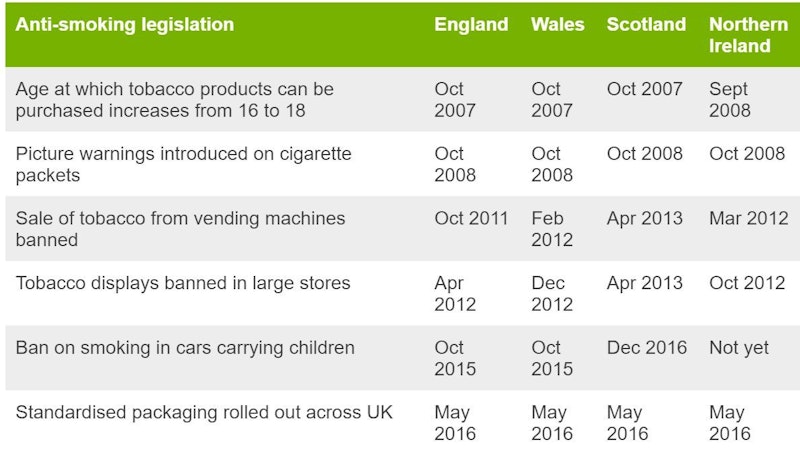Teaching activity
Evaluating the pub smoking ban
1st October 2017
While browsing the BBC website, I have come across this set of 10 charts that show the effect of the ban smoking in all enclosed public places and work places since it came into force in England on 1 July 2007 - it makes a resource which offers some excellent potential for students to practice the skill of evaluation of how effective it has been.
It is quite hard to remember, now, the days when pubs were full of smoke, and non-smoking diners might find themselves next to a table where someone lit up after finishing their meal. There is no doubt that the 'pub smoking ban' has widespread support; a poll of more than 4,000 adults by YouGov released for the 10th anniversary found nearly three-quarters of people would oppose the ban being overturned, with just 12% wanting to get rid of it.
We can only evaluate the ban's success, if we know what it was supposed to achieve. The primary purpose was to prevent smokers from putting others at risk by exposing them to second-hand smoke - a classic example of negative externalities which impact on third parties. But there is also an element of 'nudge' here - if the smokers need to go outside in the cold and wet, and suffer the walk of shame to the designated smoking area, perhaps over time they are more likely to change their habits and give up smoking. Two points which can be analysed using economic theory.
On to evaluation. I would suggest that there are a number of approaches to this, using the charts. Chart 8 shows that the incidence of lung disease amongst bar workers, which would be a good proxy for measuring the impact of negative externalitiies from public smoking, fell dramatically even in the first year. There is similar data showing a reduction in heart attacks and the incidence of lung cancer throughout the population (chart 9) has also fallen. However, the lung cancer figures show that the rate for women is actually rising, so the overall figure cannot be attributed to passive smoking alone. Chart 6 also shows that there are still around 10% of pregnant women who smoke, thus potentially causing negative externalities of harm to their babies. So we might conclude that the ban appears to have had some effect, but that there is still some way to go.
Evaluating the impact on the number of smokers, Chart 5 shows clear evidence that people have been influenced to give up smoking and that the ban has helped - people were motivated to protect those they smoked around (ie. awareness of the negative externalities), as well as looking after their own health, both of which shift the Marginal Private Cost curve closer to the Marginal Social Cost.
Charts 3 and 4 also show that there are fewer smokers, and particularly among the young - the number of 11-16 year olds who have taken up smoking has halved since 2007. But the text notes that the decline in smokers is less steep since the ban than it was before, and that the patterns of drinking rates, drug use and teen pregnancy amongst young people have also improved over the same period, so there is a critique of the data which questions whether the decline is down to the ban, or to other factors. One of those factors might be the substitute good of vaping. Figures from the Office for National Statistics show that today one in 20 people over 16 regularly uses e-cigarettes - and only a quarter of them are smokers or ex-smokers.
Chart 7 is also important here, as it shows that the effectiveness of the ban varies with different income groups. Those with low incomes are still almost twice as likely to smoke as those with high incomes over £40,000 a year.
Finally we should look at the risks of government failure, when intervention is aimed at correcting market failures. One risk is that the intervention will prove too costly to impose and enforce, but data in chart 1 suggests that the ban, which is policed by local council inspectors, has been complied with very widely. Chart 2 gives another view though, by considering the unintended consequence of pub closures, and the loss of jobs and GDP that goes with that.
Given all the factors considered, would you conclude that the ban on smoking in public places introduced in 2007 has been effective in achieving its objective? Students should decide which of the arguments above they consider to be the most significant, and why, in order to make that considered judgement.

You might also like

Scotland introduces a minimum charge for plastic bags
21st October 2014

Cigarettes, demerit goods and government failure
12th July 2013

Climate Change Policies - Finding the Right Mix
30th April 2012

Information Economics - How Many Sugars in a Coke?
5th January 2014
25 stories on Market Failure
21st January 2016
Alcohol information failure
13th January 2010
Housing Market Failure (Revision Presentation)
Teaching PowerPoints
Development Barriers - Corruption and Conflict
Study Notes